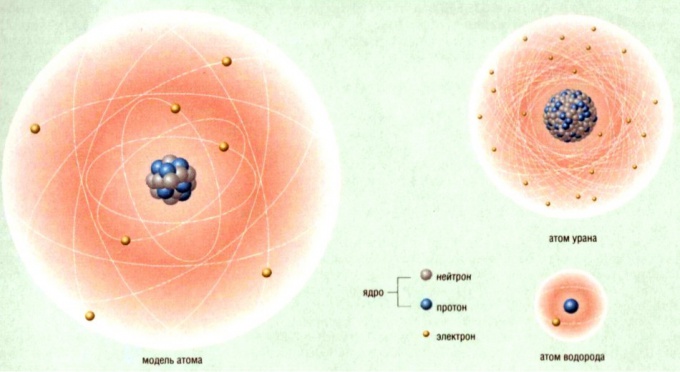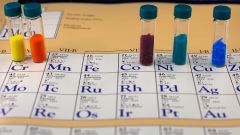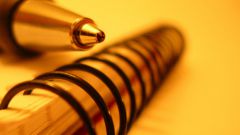You will need
- To determine the number of atoms in the substance take accurate scales (lever or electronic), the periodic table, pressure gauge, thermometer.
Instruction
1
Determining the number of atoms in a pure substance
Weigh the sample of the test substance on an accurate scale, the result is in grams. Make sure that it consists of monatomic molecules. Then, using the periodic table find the molar mass of analyte, expressed in grams per mole. To do this, find the element corresponding to the substance, which consists of a body and write its molecular weight. It will be equal to the molar mass expressed in grams per mole. For example, for iron (Fe) is 55,845 g/mol. If accurately known isotope, such as iron-55, it is possible to take an integer, true, pure isotopes are often radioactive. Then the mass of a substance divide by its molar mass, and multiply the result by 6,022*10^23. This will be the number of atoms in a given mass of the substance.
Weigh the sample of the test substance on an accurate scale, the result is in grams. Make sure that it consists of monatomic molecules. Then, using the periodic table find the molar mass of analyte, expressed in grams per mole. To do this, find the element corresponding to the substance, which consists of a body and write its molecular weight. It will be equal to the molar mass expressed in grams per mole. For example, for iron (Fe) is 55,845 g/mol. If accurately known isotope, such as iron-55, it is possible to take an integer, true, pure isotopes are often radioactive. Then the mass of a substance divide by its molar mass, and multiply the result by 6,022*10^23. This will be the number of atoms in a given mass of the substance.
2
The number of atoms in a complex substance
If the substance consists of polyatomic molecules, for example, water molecule consists of one oxygen atom and two hydrogen atoms, make the following sequence of actions. Using the scales, find the mass of the sample. Then, write down its chemical formula, and using the periodic table find the molar mass of each of the atoms that comprise the molecule. In the case of water it is hydrogen – 1 gram per mole, and oxygen is 16 grams per mole. Because of hydrogen 2 atoms, multiply the molar mass by this number, the result is the total molar mass of 18 grams per mole. Then the mass in grams divided by the molar mass in grams per mole and multiply by 6,022*10^23. The result is the number of molecules in the substance, this number is multiply by the number of atoms in one molecule (for water it is equal to 3).
If the substance consists of polyatomic molecules, for example, water molecule consists of one oxygen atom and two hydrogen atoms, make the following sequence of actions. Using the scales, find the mass of the sample. Then, write down its chemical formula, and using the periodic table find the molar mass of each of the atoms that comprise the molecule. In the case of water it is hydrogen – 1 gram per mole, and oxygen is 16 grams per mole. Because of hydrogen 2 atoms, multiply the molar mass by this number, the result is the total molar mass of 18 grams per mole. Then the mass in grams divided by the molar mass in grams per mole and multiply by 6,022*10^23. The result is the number of molecules in the substance, this number is multiply by the number of atoms in one molecule (for water it is equal to 3).
3
The number of atoms in mixtures and alloys
If the substance is a mixture of several substances with known mass fractions, measure its total weight. Then find the masses of pure substances by multiplying the mass of the relevant shares. For example, if the bronze contains 70% copper and 30 % tin, but to obtain the mass of copper multiply the mass of the sample is 0.7, and for the mass of tin will multiply the sample size by 0.3. Then proceed as described in the preceding paragraphs.
If the substance is a mixture of several substances with known mass fractions, measure its total weight. Then find the masses of pure substances by multiplying the mass of the relevant shares. For example, if the bronze contains 70% copper and 30 % tin, but to obtain the mass of copper multiply the mass of the sample is 0.7, and for the mass of tin will multiply the sample size by 0.3. Then proceed as described in the preceding paragraphs.
4
The number of atoms in the gas
If the gas is in normal conditions (pressure of 760 mm Hg. article and temperature of 00C), determine the volume of this gas in geometric methods (for example, to find the volume of gas in the room which is a cuboid, multiply the length, width and height), expressing it in cubic meters. The number you divide by and multiply by 0,0224 6,022*10^23. If a diatomic gas molecule, then multiply the result by 2.
If you know the pressure, volume and temperature of the gas (the pressure measured by the manometer, and the temperature with a thermometer), then find the product of the pressure in Pascals the volume in cubic metres, divide by the temperature in Kelvins, and the number of 8.31. The result multiply by 6,022*10^23 number of atoms in the gas molecule.
If the gas is in normal conditions (pressure of 760 mm Hg. article and temperature of 00C), determine the volume of this gas in geometric methods (for example, to find the volume of gas in the room which is a cuboid, multiply the length, width and height), expressing it in cubic meters. The number you divide by and multiply by 0,0224 6,022*10^23. If a diatomic gas molecule, then multiply the result by 2.
If you know the pressure, volume and temperature of the gas (the pressure measured by the manometer, and the temperature with a thermometer), then find the product of the pressure in Pascals the volume in cubic metres, divide by the temperature in Kelvins, and the number of 8.31. The result multiply by 6,022*10^23 number of atoms in the gas molecule.
Note
How to find the number of atoms in the substance. To find the number of atoms in the substance, determine what the substance is. Then find its mass and molar mass. Then the ratio of the mass and the molar mass multiply by Avogadro's number, 6,022*1023. You will need.
Useful advice
The method is based on the relationship between the atomic (or molecular) mass of a crystalline substance, its density, and Avogadro's number and a certain coefficient, which is determined from distances between atoms in the crystal lattice. Knowing this number, the various methods which have been tried in 1908-1910, to find the number N. it is Possible to collect α-particles in the Faraday Cup to measure their charge and dividing it by the number of particles to charge of each of them; half of it gives us the elementary charge, which is determined by the number N...


